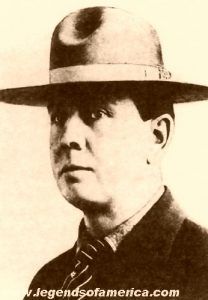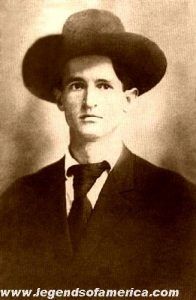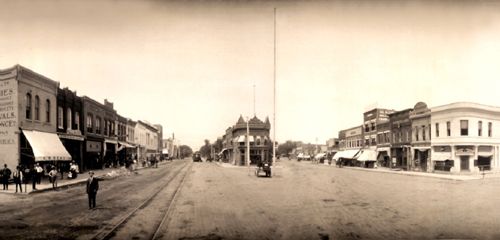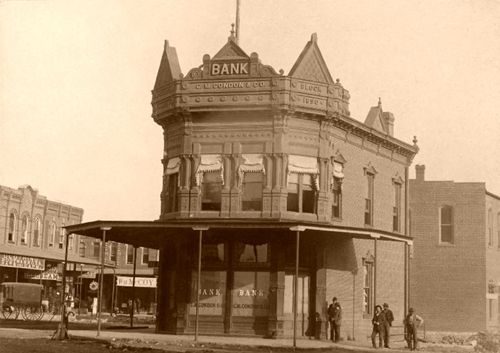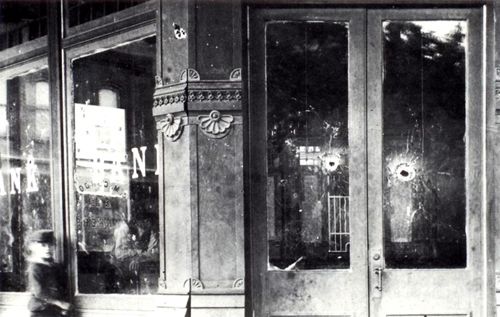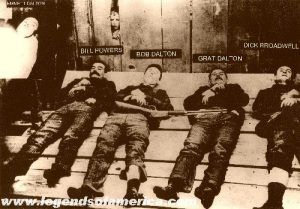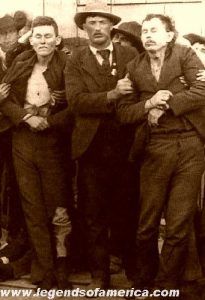
Westport, Missouri, 1890
The Dalton Gang was a group of outlaws who primarily operated in Oklahoma and Kansas between 1890-1892. They were also known as the Dalton Brothers because three of its members were brothers. The gang specialized in bank and train robberies.
The Dalton brothers at one time were on the side of the law, but turned outlaws in the 1890s, with some meeting their end in Coffeyville, Kansas during a daring double bank robbery.
The Dalton brothers were part of a large family headed by parents Adaline Younger Dalton and James Lewis Dalton. Lewis Dalton came west from Kentucky to Missouri during the late 1840s and in the 1850s, he was trading horses and running a saloon in Westport, Missouri (now Kansas City) when he married Adeline. Adeline’s brother was the father of Bob Younger, Cole Younger, and James Younger.
Most of their 15 children were born in Missouri before the family migrated to Indian Territory (Oklahoma) in 1882.
In 1886, they moved again to a place near Coffeyville, Kansas. In this rough and wild area, the Dalton brothers inherited a tradition of violence on the bloody ground of the Missouri-Kansas border, where Quantrill’s Raiders and other guerilla bands operated before and during the Civil War.
When the Oklahoma Territory opened for settlement in 1889, the family headed south again. However, Lewis died along the way leaving Adaline to raise the younger children alone. Adaline continued on, placing a claim on the banks of Kingfisher Creek in Indian Territory, where initially, she and the family lived in a dugout. By this time the older Dalton brothers were on their own.
For a short time, the brothers served on the side of the law, working as U.S. Deputy Marshals. Their older brother, Frank Dalton, was commissioned a Deputy Marshal for the federal court in Fort Smith, Arkansas and Bob Dalton served on several of his posses. On November 27, 1887, in a gun battle with the Smith-Dixon Gang, Frank Dalton was shot and killed in the line of duty.
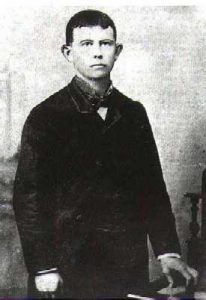
Grat Dalton
Grat Dalton followed in Frank’s footsteps, first taking his place as a Deputy Marshal in Fort Smith, Arkansas and two years later as a Deputy Marshal for the Muskogee court in Indian Territory in 1889. That same year he received a bullet in his arm while attempting to arrest a suspect. Bob Dalton was also commissioned as a Deputy Marshal for the federal court in Wichita, Kansas, working in the Osage Nation, in 1889.
Bob Dalton, who would later become the leader of the Dalton Gang, was the wildest of the bunch. When he was just 19, he killed a man, claiming it was in the line of duty. Nevertheless, some suspected that the victim had tried to take away Bob’s girl.
While Emmett Dalton worked as a member of some of his brothers’ posses, he made his living working as a cowboy on the Bar X Bar Ranch near the Pawnee Agency in the present-day Osage Nation. While working at the ranch, Emmett met two men who would later become members of the gang — Bill Doolin and William St. Power, alias Bill Power. Power, also known as Tom Evans, who had drifted into the area from Texas with a trail herd from the Pecos.
Emmett also made the acquaintance of several other cowboys working on nearby ranches who would later become part of the gang. These included Charlie Pierce, George “Bitter Creek” Newcomb, Bill EcElhanie, Charlie Bryant, and Richard “Dick” Broadwell, alias Texas Jack and John Moore.
Charlie Pierce was from the Blue River country in Missouri but headed to Indian Territory to avoid serving jail time for whiskey peddling.
Dick Broadwell was from a prominent family near Hutchinson, Kansas and at the opening of Oklahoma Territory, he staked a claim to a homestead in the Cowboy Flats area. There, he met and a young lady who owned the homestead next to his and asked her to marry him. After their marriage, she persuaded him to sell both claims and move with her to Fort Worth, Texas, where she disappeared with their money. The embittered Broadwell returned to Indian Territory and started work on the ranches.
George Newcomb, who was known as “Bitter Creek” Newcomb, was originally from Fort Scott, Kansas. Starting his career as a cowboy at the age of 12, he worked for C. C. Slaughter on the Long S Ranch in Texas before drifting into Indian Territory.
Charlie Bryant came from Wise County, Texas. He had a gunpowder burn on his cheek that earned him his nickname “Black-Faced Charlie.”
For a short time, the Dalton brothers served with distinction on the side of the law. But, a narrow margin separated the lawless from the law enforcers during those rough times. Slipping from one side to the other, Bob Dalton, along with his brother Emmett, were charged with selling whiskey in the Osage Nation on March 21, 1890.
Jumping bail, Bob and Emmett headed to New Mexico. Forming their first “gang”, Bob recruited George “Bitter Creek” Newcomb, Bill EcElhanie, and “Blackfaced Charlie” Bryant to ride with them. It was at a gambling house in Silver City, New Mexico that the Dalton Gang committed their first robbery.
After riding into the mining camp, the crew sat down at a faro game, where they lost heavily. Convinced the game was crooked, they pulled their guns, taking back what they had lost and then some. Bob and Emmett then fled to California, where their younger brother Bill was a successful farmer and rancher.
In September 1890, Grat was arrested for stealing horses but was later released for lack of evidence. Grat lost his job as a Deputy Marshal for conduct unbecoming an officer, but he still worked as a posse man for other deputy marshals in the area for a time. Later, he too, left Indian Territory, joining his brothers in California.
Before Bob, Emmett, and Grat arrived at Bill’s ranch in California, Bill had married, was living a respectable life, and had become involved in politics as part of the Populist Party. During this time, Bill became embroiled in a Populist fight with the railroad backed political machine, referring to the railroad as the S.P. Robber Barons. This political fight was based on battles between the Southern Pacific Railroad and local farmers over land disputes.
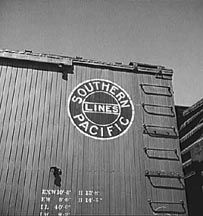
Southern Pacific Railroad
Bill’s anger with the railroad is thought to be one of the reasons the brothers decided to rob a Southern Pacific train headed to Los Angeles on February 6, 1891. Prior to this robbery, Bill had not been in trouble with the law at all. Bill, along with Bob, Grat, and Emmett attempted to hold up the train at Alila, California, but this first attempt at train robbery was a fiasco. While Bill kept the passengers from interfering by shooting over their heads, the others forced the engineer to show them the location of the cash-carrying express car. When the engineer, a man by the name of George Radcliffe, tried to slip away, he was shot and killed.
Finding the express car on their own, the guard refused to open the heavy door and began firing on them. Thwarted, the brothers finally gave up and rode away.
Bob and Emmett then fled California with a posse on their tail; however, Grat and Bill were arrested. Bob and Emmett made their way back to Indian Territory and hooked up with Emmett’s old ranching buddies Charlie Bryant and Bitter Creek Newcomb. In May 1891, the four robbed the train at Wharton, Indian Territory making off with $1,745. Meanwhile, in California, Grat Dalton was found guilty of the train robbery on July 3, 1891, and was sentenced to 20 years in prison.
Three months after the Wharton robbery in August 1891, Charlie Bryant became ill and was taken to the doctor in Hennessey, Oklahoma Territory. While there, Deputy Marshal Ed Short arrested Bryant while he was recovering from his illness at a local hotel. There being no jail in Hennessey, the marshal loaded Bryant on a train and headed to the federal jail in Wichita. In route, Bryant somehow obtained a gun and attempted to escape. In the ensuing shoot-out between Bryant and Short, both men were killed by shots from the other.
The Dalton Gang’s next robbery was the Missouri-Kansas-Texas Railway at Leliaetta, near Wagoner in Indian Territory. With Bob and Emmett, were Bitter Creek Newcomb, Bill Power, Dick Broadwell, Charlie Pierce, and Bill Doolin. On the night of September 15, 1891, they stopped and boarded the MK&T train, and robbed the express car of $2,500.
Back in California, on September 18, Grat escaped while on the train transferring him to prison. According to one account, Grat was handcuffed to one of two deputies that accompanied him. While one of the deputies was asleep and the other busy talking to other passengers, Grat stole the key to the handcuffs and jumped from the window of the moving train, landing in the San Joaquin River. Grat made his way back to Oklahoma, and quickly joined back up with the gang, while his brother Bill was still in California awaiting trial.
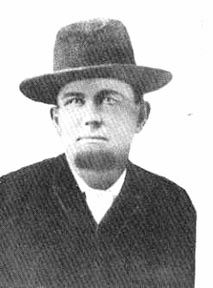
William “Bill” Dalton
In the end, Bill Dalton was acquitted on October 10, 1891, for the train robbery that Grat had been sentenced to 20 years for.
The winter of 1891 found the Dalton brothers relatively quiet, but as soon as spring arrived they teamed up with Pierce, Newcomb, Power, Broadwell, and Doolin to plan another train holdup.
Waiting for the train at the station on June 1, 1892, at Red Rock, Oklahoma, they sensed danger when the train arrived without any lights shining from its coach windows. Quickly, they abandoned their plans and allowed the train to pass without incident. However, within a short time a second train came along, and this one, they boarded.
Charlie Bryant and Dick Broadwell held the engineer and fireman in the locomotive while Bob, Emmett, and Bill Power walked through the passenger cars taking jewelry and cash. Bill Doolin and Grat Dalton took on the express car, throwing the safe out of the train. Loot in hand, the bandits rode away, only to discover they had gained little for their efforts, as the safe only contained about $50.
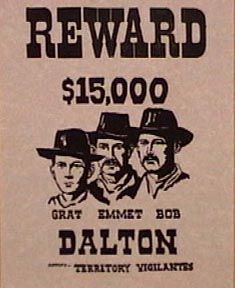
Dalton Wanted Poster
Later, they found out that their suspicions were correct regarding the train that they had allowed to pass as it had been full of armed guards protecting $70,000 of the Sac and Fox annuity.
Obviously not happy with their take in June, they planned another train heist on July 14, 1892, at Pryor Creek in Indian Territory. Arriving at the train station they first took what they could find from the express and baggage rooms, then calmly sat down waiting for the train to arrive with their shotguns over their knees. Once again the train was loaded with deputies, but for some reason, they were all at the back of the train. The gang backed a wagon up to the express car and unloaded all of the contents, easily subduing the one armed guard in the express car. When the marshals finally discovered the robbery, a fierce gun battle broke out where two guards were killed, as well as an innocent bystander, and another was wounded. The gang escaped unharmed making off with $17,000 in cash. After this train robbery, a prize of $5,000 was placed on each of the Daltons’ heads.
With the law hot on their tails, the Dalton Gang split up for a short time. But, it wasn’t long before they began to plan another robbery – this one to be their biggest yet.
In early October 1892, brothers Bob, Grat, and Emmett Dalton, along with Bill Power and Dick Broadwell set out toward Coffeyville, Kansas. Arriving on the evening of October 4th at the P.L. Davis farm four miles west of Coffeyville, they made camp for the night and prepared for the next day.
Early on the morning of October 5, 1892, the five outlaws rode into Coffeyville shortly after 9:00 a.m. to find the city’s streets filled with people. Tying their horses in an alley across from the banks, they dismounted and marched down the alley, three in front and two in the rear. The outlaws, disguised with false beards, divided into two groups, with Grat, Power, and Broadwell entering the C.M. Condon & Co. Bank, and Bob and Emmett crossing the plaza to enter the First National Bank.
Disguise or no, when they left the alley they passed within five feet of a man by the name of Aleck McKenna, who recognized one of them as a member of the Dalton family. He watched the men as they entered the bank and when he saw a gun pointed at the cashier’s counter in the Condon Bank, he called out “the bank is being robbed!” The cry was taken up and quickly passed to everyone around the square. Wasting no time, the local townsmen quickly armed themselves with weapons from the hardware store and took up positions to defend the town.
Inside the Condon Bank were C.T. Carpenter, one of the owners; Tom C. Babb, bookkeeper; and Charles M. Ball, cashier. They were quickly taken hostage by the outlaws and ordered to surrender the money. But quick-thinking cashier Ball told them there was a time lock on the vault and that it could not be opened for another 10 minutes. Grat, Power, and Broadwell were fooled into waiting, which gave the townsmen additional time to get themselves armed.
Meanwhile, in the First National Bank, Bob and Emmett captured Thomas G. Ayers, cashier; W.H. Shepard, and B.S. Ayers, the bookkeeper, who they forced to collect the money. The two Dalton brothers at first tried to escape out the front door using the three bankers as a shield. But when the townsmen shot at them anyway, they decided to use the rear door.
While waiting at the Condon Bank, bullets began to punch through the bank windows, and Grat, Broadwell, and Power charged out of the bank into the plaza. All three were hit as they ran toward the alley. Bob and Emmett ran around a block, pausing long enough to kill two citizens, and entered the alley at about the same time that Grat and the others got there.
Finding cover behind an oil tank, Grat fired several wild shots as John J. Kloehr, Carey Seamen and Marshall Connelly followed them into the alley.
Grat shot and killed Marshal Connelly. Someone hit Bob Dalton, who sat down, fired several aimless shots, slumped over, and died. John Kloehr put the wounded Grat down for good with a bullet in the neck. Power died in the dust about 10 feet away. Already mortally wounded, Broadwell got to his horse and rode a half-mile toward safety before he pitched out of the saddle and died in the road.
Emmett, who was carrying the money bag, tried to mount his horse but was hit in the right arm, left hip, and groin. He then rode back for his brother Bob, and as he reached down for him, Carey Seamen unloaded both barrels of his shotgun into Emmett’s back and Emmett dropped to the alley. Emmett then held up his uninjured hand and surrendered. He was taken to Dr. Well’s office with 20 bullets and the doctor said he would be dead before nightfall. However, 21-year-old Emmett survived.
The entire gun battle had lasted less than 15 minutes after the robbers had entered the banks. Eight men were dead and three were wounded. In addition to the four outlaws who were killed, four local men were killed including Marshal Charles Connelly, Lucius Baldwin, George Cubine, and Charles Brown.
Emmett stood trial and was sentenced to life in prison. However, due in part to his friends on the right side of the law who thought he was not beyond redemption, Emmett was pardoned in 1907. On September 1, 1908, Emmett married Julia Johnson Gilstrap Lewis in Bartlesville, Oklahoma where they lived for a couple of years before moving to California. In California, Emmett worked as a building contractor and later would write a book about the exploits of the Dalton Gang entitled “When The Daltons Rode.” Written in collaboration with Jack Jungmeyer, a Los Angeles Newspaperman, the book was published in 1931.
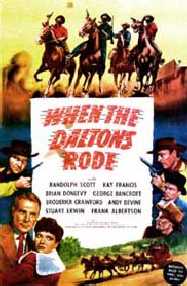
When the Daltons Rode
In May of 1931, Emmett and Julia returned to Coffeyville for a visit, where they were treated like celebrities. Emmett died at home in Long Beach, California on July 13, 1937. In 1940, shortly after Emmett’s death, the book was made into a western movie starring Randolph Scott, Broderick Crawford, Andy Devine, and Kay Francis. Julia Dalton was associated with the filming as a sort of technical advisor. Later, she went to Coffeyville, Kansas, for the picture’s premiere.
Coffeyville was not the end of the Dalton Gang. Three members of the old gang remained at large; Bill Doolin, Bitter Creek Newcomb, and Charlie Pierce. In fact, Bill Doolin is thought by many historians to be a sixth member of the gang which hit Coffeyville, holding the horses in the alley, and the only member to have escaped. Bill Dalton also joined the former members of the gang, and they would terrorize the Territories for several years as the infamous Doolin-Dalton Gang.
As to the ultimate fate of the other gang members:
George “Bitter Creek” Newcomb met a 15-year-old girl named Rosa Dunn, known as “The Rose of Cimarron.” Eventually, he sought refuge at her parent’s ranch, and her brothers turned him in for the $5,000 reward on his head. He was shot by U.S. Deputy Marshals on May 2, 1894, in Oklahoma.
Charlie” Pierce was with George “Bitter Creek” Newcomb and was also killed by U.S. Deputy Marshals on May 2, 1894, in Oklahoma.
Bill Doolin was killed in August 1896 by U.S. Deputy Marshal Heck Thomas near Lawson, Oklahoma. Bill Dalton went on the run after robbing the First National Bank in Longview, Texas, and was killed by lawman, Loss Hart, at Elk, Oklahoma on June 7, 1894.
“Blackface Charlie” Bryant was arrested by U.S. Deputy Marshal Edward Short in the summer of 1891 and while he was being transported to the federal court in Wichita, Kansas, on August 3, 1891, Bryant stole a gun and shot Marshal Short. The lawman returned fire and when the smoke cleared both men were dead.
“DALTONS! The Robber Gang Meet Their Waterloo in Coffeyville. The Outlaws Beaten at Their Own Game.”
— Headline on the Coffeyville Journal on Friday, October 7, 1892
© Kathy Weiser/Legends of America, updated March 2023.
Also See:
Coffeyville Raid Newspaper Accounts
Dalton Gang Shoot-out in Coffeyville, Kansas
The Dalton Brothers – Lawmen & Outlaws

